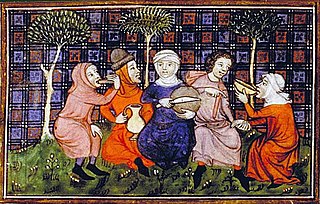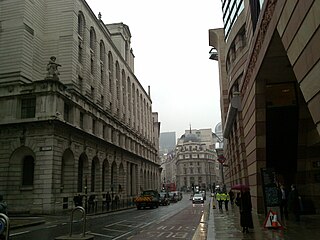Related Research Articles

French cuisine is the cooking traditions and practices from France. In the 14th century, Guillaume Tirel, a court chef known as "Taillevent", wrote Le Viandier, one of the earliest recipe collections of medieval France. In the 17th century, chefs François Pierre La Varenne and Marie-Antoine Carême spearheaded movements that shifted French cooking away from its foreign influences and developed France's own indigenous style.

A kitchen is a room or part of a room used for cooking and food preparation in a dwelling or in a commercial establishment. A modern middle-class residential kitchen is typically equipped with a stove, a sink with hot and cold running water, a refrigerator, and worktops and kitchen cabinets arranged according to a modular design. Many households have a microwave oven, a dishwasher, and other electric appliances. The main functions of a kitchen are to store, prepare and cook food. The room or area may also be used for dining, entertaining and laundry. The design and construction of kitchens is a huge market all over the world.

A larder is a cool area for storing food prior to use. Originally, it was where raw meat was larded—covered in fat—to be preserved. By the 18th century, the term had expanded: at that point, a dry larder was where bread, pastry, milk, butter, or cooked meats were stored. Larders were commonplace in houses before the widespread use of the refrigerator.
A royal household or imperial household is the residence and administrative headquarters in ancient and post-classical monarchies, and papal household for popes, and formed the basis for the general government of the country as well as providing for the needs of the sovereign and their relations. It was the core of the royal court, though this included many courtiers who were not directly employed by the monarch as part of the household.
A boning knife is a type of kitchen knife with a sharp point and a narrow blade. It is used in food preparation for removing the bones of poultry, meat, and fish. Generally 12 cm to 17 cm in length, it features a very narrow blade. Boning knives are not as thick-bladed as some of other popular kitchen or butcher knives, as this makes precision boning, especially deep cuts and holes easier. A stiff boning knife is good for boning beef and pork, but a very flexible boning knife is preferred for poultry and fish.
The still room is a distillery room found in most great houses, castles or large establishments throughout Europe dating back at least to medieval times.

Methwold is a village and civil parish in the English county of Norfolk, on the edge of the Norfolk Fens and Breckland. With an area of 49 km2 (19 sq mi) it is the second largest parish in Norfolk. It had a population of 1,502 in 591 households at the 2011 Census, up by less than 2% from 1,476 at the 2001 census, For the purposes of local government, it falls within the district of King's Lynn and West Norfolk.

Palladam is a town and First Grade Municipality in Tirupur district in the state of Tamil Nadu, India. It is the headquarters of Palladam Taluk of Tirupur district. Palladam is located on National Highway NH 81. Palladam is a major town with large source of income collected from the business community, which includes Textile industries, Poultry farms, and Agriculture. Palladam High-tech weaving park is a milestone of the town. It is a part of the Coimbatore MP Constituency. Palladam is well known for production of Broiler chicken production and head office of Broiler coordination committee (BCC) situated here.

Medieval cuisine includes foods, eating habits, and cooking methods of various European cultures during the Middle Ages, which lasted from the 5th to the 15th century. During this period, diets and cooking changed less than they did in the early modern period that followed, when those changes helped lay the foundations for modern European cuisines.
A saucery was the office in a medieval household responsible for sauces, as well as the room in which the preparation of sauces took place. It was headed by a saucerer. The office was subordinated to the kitchen, and existed as a separate office only in larger households. It was closely connected with other offices of the kitchen, such as the spicery and the scullery. The term is largely obsolete today.
A spicery was the office in a medieval or Renaissance household responsible for spices, as well as the room in which the spices were kept. It was headed by a spicerer. The office was subordinated to the kitchen or the wardrobe, and existed as a separate office only in larger households. It was closely connected with other offices of the kitchen, such as the saucery and the scullery. The term is largely obsolete today, and if used at all is more often simply a synonym for spices.
A chandlery was originally the office in a wealthy medieval household responsible for wax and candles, as well as the room in which the candles were kept. It could be headed by a chandler. The office was subordinated to the kitchen, and only existed as a separate office in larger households.
A scalding house was the office in a medieval household responsible for scalding the carcasses of animals, as well as utensils. It was also the room in which this activity took place. It was headed by a scalder. The office was subordinated to the kitchen, and existed as a separate office only in larger households. It was closely connected with other offices of the kitchen, such as the saucery and the scullery.

Clanbrassil Street is a street in Dublin south of the city centre. It runs from Robert Emmet Bridge on the Grand Canal to New Street. It is served by several bus routes. It is divided into Clanbrassil Street Upper and Clanbrassil Street Lower.

Poultry is a short street in the City of London, which is the historic nucleus and modern financial centre of London. It is an eastern continuation of Cheapside, between Old Jewry and Mansion House Street, towards Bank Junction.
Poultry refers to domesticated birds kept by humans for their eggs, meat, feathers, or as pets.
Utilis Coquinario is an English cookery book written in Middle English at the turn of the fourteenth century. The title has been translated as "Useful for the Kitchen". The text is contained in the Hans Sloane collection of manuscripts in the British Library and is numbered Sloane MS 468.

Records survive of the expenses made to feed the Scottish royal household in the sixteenth century, and the remains of royal kitchens can be seen in the ruins of palaces and castles. Archaeologists can recover evidence of diet from deposits including waste from meals and food preparation.

1 West Bridge Street is an historic building in the Bridgend area of Perth, Scotland. A former tollbooth building, it is a Category C listed building dating to around 1800 and is located on the southern side of the eastern end of Perth Bridge. The part of the building that curved around onto Commercial Street has been demolished.

One of the earliest documented uses of Yeoman, it refers to a servant or attendant in a late Medieval English royal or noble household. A Yeoman was usually of higher rank in the household hierarchy. This hierarchy reflected the feudal society in which they lived. Everyone who served a royal or noble household knew their duties, and knew their place. This was especially important when the household staff consisted of both nobles and commoners. There were actually two household hierarchies which existed in parallel. One was the organization based upon the function (duty) being performed. The other was based upon whether the person performing the duty was a noble or a commoner.
References
- ↑ "poulterer". Merriam-Webster . Retrieved 2008-01-20.
- ↑ Woolgar, C. M. (1999). The Great Household in Late Medieval England. New Haven and London: Yale University Press. p. 144. ISBN 0-300-07687-8.